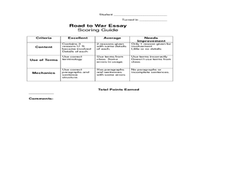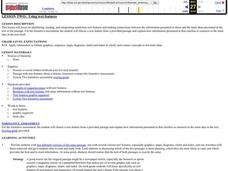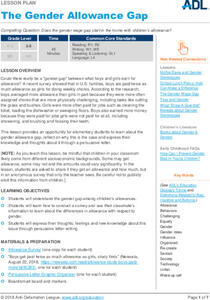Curated OER
Monitoring an Epidemic: Analyzing Through Graphical Displays Factors Relating to the Spread of HIV/AIDS
Tenth graders differentiate pandemic and epidemic. In this health science instructional activity, 10th graders analyze how HIV and AIDS affect different countries. They construct and interpret different types of graphs.
Curated OER
Tell Me More
Fifth graders demonstrate research techniques in addition to endeavoring to display focus and stay on topic. Using books and stories, they gather, organize, and share information about a topic. Additionally, they explain to the class...
Smithsonian Institution
Cold War
The Cold War was not necessarily always cold in temperature, but the relationship between the United States and the Soviet Union sure was frigid! Scholars read various passages, view exhibition graphics, and observe an artifact from the...
iCivics
Step Four: Working with Websites
Almost every profession today relates to websites in some way! The resource tasks the class to fill out three individual graphic organizers to help them analyze each website they visit.
Curated OER
Helpful Animals and Compassionate Humans in Folklore
Learners define elements of stories from around the world that include helpful animals. They explore animal character motivations and use graphic organizers to compare and contrast animal stories from different cultures.
Curated OER
Early U. S. Involvement in World War II
Ninth graders examine how the U. S. was aided by the Allies in World War II before the U. S. declared war. They analyze the evolution of U. S. foreign policy from the beginning of WW II through U. S. Declaration of War
Curated OER
Chapter 39: The Economics of Developing Countries
The disparity between the standards of living in industrialized countries versus developing countries has gotten wider - and this presentation can help your class learn why. With a multitude of key definitions and facts, these slides go...
PBS
Thomas Edison: Inventor and Entrepreneur
How many of Thomas Edison's inventions do your scholars use every day? They might be shocked to find out! Young historians watch a video, analyze a photograph, and read one of Edison's letters to learn more about his life and impact....
PBS
Walt Whitman: Journalist and Poet
Can you love something so much you want to change it? Young patriots investigate Walt Whitman's love of America—and his suggestions to improve it—using primary sources as well as video evidence. Scholars research American issues of the...
PBS
Mark Twain: Storyteller, Novelist, and Humorist
Scholars investigate the use of satire in Mark Twain's writing. Literary lovers research the Adventures of Huckleberry Finn and Tom Sawyer, political cartoons, and videos to see how Twain uses satire to make the stories more memorable....
EngageNY
Learning About Farms in Colonial America: Explicit vs. Inferred Information
Aid your pupils in understanding the terms explicit and inferred while teaching them about colonial farmers. The third activity in the module builds off the previous activity and focuses heavily on inference. Learners analyze a...
National Woman's History Museum
Tea with Penelope: A 2-Point Perspective of the Edenton Tea Party
A brief introduction to Penelope Barker sets the stage for a discussion about political cartoons and the persuasive technique used to create them. A graphic organizer aids scholars in the analysis of a piece of work using a 2-point...
Center for History Education
Northern Racism and the New York City Draft Riots of 1863
Just how racist were some people in the North during the American Civil War? Using excerpts of the Conscription Act, as well as graphic images of lynchings, young historians consider why white people in New York City rioted and killed...
Curated OER
A look at our larger population
Student team together to tell the story of the U.S.'s rapid population growth. High schoolers research census changes, focusing on changes in the size of the community and the school. Students tell the story by writing articles and...
Curated OER
Using Text Features
Fourth graders read a nonfiction story that is presented to them with graphic features, and presented to them with only the text. In this text features lesson, 4th graders decide what the benefits of text organizers are and create...
Curated OER
Worksheet for Choosing a Research Paper Topic & Developing a Thesis Statement
How do you choose a research topic? This helpful graphic organizer is provided to aid middle and high schoolers in organizing their initial thoughts and choosing a topic. They have to narrow their topic by culture, time frame, event,...
Center for History Education
Road to Revolution: How did Actions and Responses Lead to an Independent United States?
Using primary sources, maps, and an interactive M&M game, young historians examine the American revolution as if they were detectives trying to solve a crime. Resource includes graphic organizers and a final writing prompt to aid...
Curated OER
Respecting Diversity- The Road to Tolerance
Students use a graphic organizer to find similarities and differences in three religions. In this prejudice lesson plan, students understand the events leading up to the holocaust. Students understand that people who respected diversity...
Curated OER
Traveling on the Orphan Train
Students explore the components and meaning of philanthropy. In this community awareness lesson, students are able to identify and research agencies and organizations that provide services to children in need, compare and contrast...
Curated OER
Cultural Practices and Products of the Local Community
Third graders examine and compare practices and products of the cultural groups that have settled in the local area. Students develop and use graphic organizers to aid them in the comparison of artistic expression, places of worship,...
K20 LEARN
Government and Your Right To Vote: Voting Rights In America
Gaining voting rights was difficult over the course of decades, but the debate over who should actually be allowed to cast a ballot remains. Scholars explore the history of the struggle, including the fifteenth and nineteenth amendments,...
Anti-Defamation League
The Gender Allowance Gap
Does the pay gap begin with allowance? That is the big question scholars answer in a lesson examining how gender affects how much money an individual earns. Class members conduct a survey to identify how the allowance is paid, take their...
Curated OER
So You Want to Be A Travel Agent?
Fourth graders create a slide show of exactly 5 pages to aid them in presenting information on their state. Slide 1 will include: state name, student name, a graphic. Slide 2 will include: name of capital city, 2 interesting places to...
Curated OER
Rivers and Coasts: How Do Rivers Change?
In this science and geography worksheet, students fill in a graphic organizer to explain how rivers change due to transportation, erosion, and deposition. They match a picture to each process to aid them in writing the explanation.
Other popular searches
- Graphic Aids Reading
- Using Graphic Aids
- Teaching Using Graphic Aids
- Use Graphic Aids
- Importance of Graphic Aids
- Text Structure Graphic Aids
- What Is Graphic Aids
- Uses of Graphic Aids
- Use of Graphic Aids
- Importance Graphic Aids























